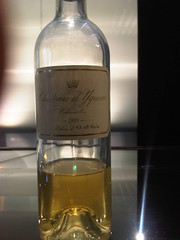Saving the best for last— My final, final at Chateau d'Yquem
Post by John Perry | Friday, April 2nd
Last day in Bordeaux. Gotta go out with a bang, and boy did I ever. Just like capping off a terrific meal, my trip ended on a high note at none other than Chateau d’Yquem. And the best part? I didn't know I was going until the boss handed me the car keys.

- Chateau d'Yquem
The day started off with a light breakfast and catching up on work at the hotel. It was one of the few off periods for me, and I spent the morning banging out blog entries, tasting notes, placing orders and catching up on emails. Truly fascinating stuff. Most of the JJB crew was off doing some morning tasting and I knew that my options when they got back would be a) more computer work or b) more negociant tastings. You can imagine my surprise when I went downstairs to chat up the boss and found out that I was going to d'Yquem! Not only going, but Shaun says, "you’re driving". Score! The best sweet wine in the world and I get to speed all over Bordeaux. (Honestly, I don't know what it is about Europe that turns our crew into Formula One wannabes.)
The d'Yquem property is set on top of the highest hill in the general vicinity. With scenic views of everything around, it was the perfect prelude to our tasting. Unlike most of our visits where there are multiple wines on offer, at d'Yquem there's only one. We drove over an hour for one wine— and it was totally worth it, seriously everything that it's cracked up to be.

- Tasting at d'Yquem, the glass is always half full, even when it's not!
Our host explained how the 2009 growing season was ideal— great for maturity of the grapes and great once the botrytis set in. Often it’s good for one or the other— either it’s an easy growing period, but then botrytis devlopment is difficult, or else it's a challenging year for ripening, but the botrytis is wonderful. The 2009 vintage was a perfect combination of both and really shows in the wine. Furthermore, we were told that this vintage was their largest production since 1893 (!) as well as having the highest level of residual sugar (the highest previous level was 2001).
A blend of 80% Semillon and 20% Sauvignon Blanc (the usual cepage for d’Yquem), which will spend 30 months aging in 100% new oak, the wine was terrific. Fabulously concentrated with notes of pineapple and apricot, opulent but extremely focused, precise and fresh, balanced by acidity and displaying excellent length. Really outstanding, and it left all the other sweet wines we had tasted on our trip in the dust.
Little did I know that we would be enjoying twenty-plus wines at dinner and I would keep the party going at a discotheque until the wee hours of the morning. But for all intents and purposes the tasting at d’Yquem was the end of our hectic trip to Bordeaux and I couldn’t have asked for a more appropriate finale.